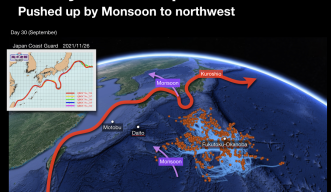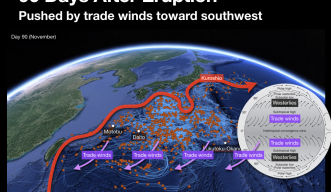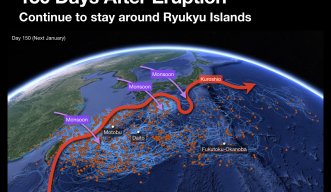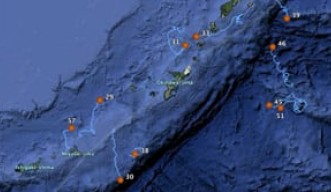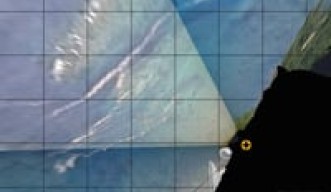The pumice around Okinawa: How long will it last and where will it go?
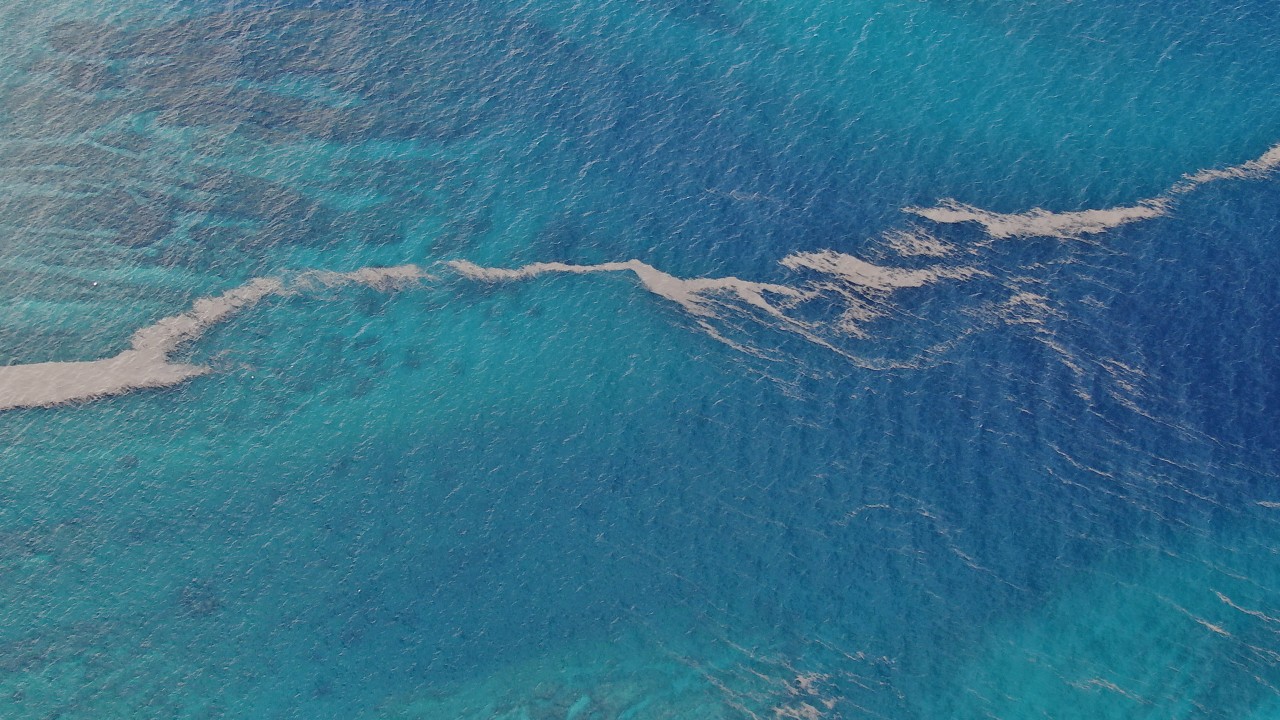
Researchers from the Okinawa Institute of Science and Technology Graduate University (OIST) have been monitoring the volcanic pumice that has been reported around the Okinawa coastline since mid-October, clogging up ports and boat engines, and impacting the fishing, transport, and tourism industries. The source of the pumice is a submarine volcano, located in the Ogasawara island chain (also known as the Bonin Islands), which erupted on August 13th, 2021. The researchers say that their work may uncover clues as to how long the pumice will remain around Okinawa and sheds light on the dynamics of pumice rafts in the ocean more broadly.
Prof. Satoshi Mitarai, who leads the Marine Biophysics Unit, related the movement of the pumice to an experiment he conducted between 2012 and 2017 when he released GPS-tagged drifting buoys into the ocean around Okinawa. The buoys mainly moved in small circles, called ocean eddies, but they weren’t strongly influenced by a passing typhoon.
“The last time the volcano erupted was in 1986 and there wasn’t nearly as much pumice reported in Okinawa. I think it’s because that eruption happened at a different time of year,” Prof. Mitarai explained.
A popular opinion is that, this time round, it was the late summer typhoons that brought the pumice to Okinawa but, given the results from his experiments with the buoys and a wave glider, a type of unmanned, autonomous robot, Prof. Mitarai doesn’t think this was the case. Instead, he concluded that the pumice was brought to Okinawa by a combination of currents and wind.
“There’s the well-known Kuroshio Current, which brings warm water north, but most people don’t know that there’s also a Kuroshio Countercurrent, which flows in the opposite direction though is much weaker. Monsoons from the south first brought the pumice to the northwest, and then a combination of the trade winds—the permanent east-to-west prevailing winds—and the Kuroshio Countercurrent brought it to Okinawa. Now, we have the seasonal, winter wind that blows predominantly from the north, which is holding a lot of the pumice against Okinawa’s coastline. These conditions will likely remain until next summer when the seasonal wind switches to blowing from the south.”



However, Prof. Mitarai went on to explain that it is unlikely mainland Japan would face the accumulation of pumice that has been seen in Okinawa. “Most of the drifting buoys remained around Okinawa for months. Very few were caught in the Kuroshio current and taken to the Tokyo area. I think it’s likely that most of the pumice will continue to beach and raft around Okinawa for some time but only a small amount will make it to the mainland.”
He said that whilst favorable wind conditions for the pumice to stay around Okinawa will remain until June 2022, there was another factor at play. “The wind, waves, solar radiation are all having their impact and it’s more probable that the pumice will break apart and sink before then. The pumice began arriving in Taiwan in early December, but much smaller pieces are being reported, as can be expected.”
Prof. Emile Touber, a fluid mechanics researcher who has also been looking at the pumice around Okinawa, added to this. He stated that the pumice stones are brittle and will rapidly turn to dust due to their frequent collisions, and the constant beaching and re-rafting. “Even the typhoons may have actually helped them break apart. The resulting dust will be diluted by the open seas before long.”
Prof. Touber leads the Shocks, Solitons and Turbulence Unit at OIST. He was observing the sea surface for almost a year before the eruption to study surface slicks (patches of smooth-looking sea surfaces) around Tancha, as part of a collaboration with Prof Vincent Laudet (who leads OIST’s Marine Eco-Evo-Devo Unit). But when pumice began to arrive in Okinawa, he realized that he could use the movement of the pumice rafts as a natural experiment to test the predictive ability of the slick-dynamic models being developed in his unit.
“It’s actually an amazing opportunity,” he said. “We’ve been directly observing the results of a natural phenomenon that can’t be planned. I’m not interested in the individual stones but rather being able to roughly estimate where the rafts will go.”
The pumice has dispersed very unevenly around Okinawa’s coastline. In some areas, such as north of the Motobu peninsula, the quantity of the pumice is significant, and seems to be staying in place due to the local tidal currents and wind. But in other areas, such as the coastline around Onna, the accumulation is more intermittent. The movement of the pumice rafts are complex, Prof. Touber explained, as they’re influenced by trade winds, seasonal wind, tidal currents, and open sea currents. They fragment following the chaotic nature of atmospheric turbulence, making detailed predictions of their whereabouts challenging.
“There are established ocean circulation models, which estimate the movement of materials across vast oceans, but these aren’t useful in close areas, like the bays here in Okinawa. By setting up a webcam at Tancha Beach in Onna-son and using a drone, my Unit has captured images of how the pumice accumulates and then disperses around the area. Tancha bay actually has another layer of complexity—there’s often a vortex current spinning at the entrance as a result of tidal flows. We’ve recorded the pumice getting caught in this.”
But Prof. Touber went on to explain that what is seen in the Tancha bay area also happens on much larger scales. Satellite photographs taken by the European Space Agency show similar patterns of pumice rafts across the water—each raft forms a finger-like shape that contains massive amounts of pumice.
Prof. Touber intends to use the footage to simulate, very roughly, the journey of patches of pumice rafts. He highlighted that the simulations will be an estimate, similar to forecasting the weather, as both systems suffer from deterministic chaos, or the “butterfly effect” in popular culture. “There are broader implications of this research. Although it’s unlikely we’ll have another event like this in Okinawa for a very long time, pumice being generated by underwater volcanoes and washing up on land is quite a common occurrence around the world. This research will help us to understand the dynamics of pumice in the ocean universally so we can give general indications of what direction it’ll move, where it might end up, and how long it’ll be there for.”
As well as pumice, this research could also aid with understanding the dispersion of coral spawning and other bio-active slicks, which is the main reason that Prof. Mitarai and Prof. Touber, alongside Prof. Tim Ravasi (who leads OIST’s Marine Climate Change Unit) and Prof. Vincent Laudet, first engaged in this research.
Specialty
Research Units
For press enquiries:
Press Inquiry Form










